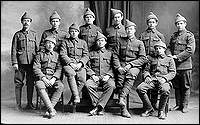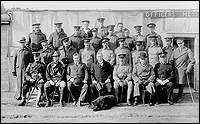|


|

|

The Newfoundland Regiment
Events moved rapidly following the British declaration of war on August 4, 1914. The formation
of the Newfoundland Patriotic Association (NPA) on August 12, provided the structure for
organizing the war effort and for raising the necessary forces for service overseas. Initially, the
Association proposed to raise 500 men for a military contingent and to increase the size of the
Naval Reserve to 1000.
The response to the proclamation of August 22 calling for volunteers was
overwhelming. Within days, 335 had signed up, two thirds coming from the city cadet brigades.
By the end of the first week, it appeared as if the entire 500 might be made up from St. John’s.
When enlistment tapered off by September 26, nearly 1000 volunteers had signed up.
Half passed the required medical exams and moved to tent lines established at nearby Pleasantville.
These were the First Five Hundred, a rag tag little army of enthusiastic volunteers, officered by the sons
of the city’s elite, and attired in a variety of military costumes, including blue puttees obtained from
a local supplier—hence their popular designation “The Blue Puttees.” The terms of
enlistment were “for the duration of the war, but not exceeding one year.” By war’s end, over four
years later, a total of 6,241 Newfoundland men had served in the regiment, 4,668 as volunteers.
(Another 5,747 enlisted in the Royal Naval Reserve, the Forestry Corps, the Canadian Expeditionary Force and
British Forces.)
No.6 Platoon, Section 8, n.d.
Courtesy of the Provincial Archives of Newfoundland and Labrador (PANL F-40-2), St. John’s,
Newfoundland.
 (46 Kb)
(46 Kb)
|
 |

|

|
 |
Various soldiers, sailors and government officials at Pleasantville, St. John’s, September,
1914.
Enlarge to view names.
Courtesy of the Provincial Archives of Newfoundland and Labrador (PANL F-30-26), St. John’s,
Newfoundland.
 (46 Kb)
(46 Kb)
|
Recruitment for the regiment was not a major problem for the first two years. However, the near
annihilation of the regiment at Beaumont Hamel on July 1, 1916, and costly major engagements in
October at Gueudecourt and at Monchy-le-Preux the following April, increased pressure on the
colony to find additional men. A draft of 500 arrived in late June and early July 1917 but the
Battle of Cambrai that November and December reduced the regiment to 250 all ranks.
While its actions at Ypres and Cambrai resulted in the regiment receiving the designation “Royal,”
recruitment now became a serious problem. In August 1917, the new National Government
created a Department of Militia. Over the course of the summer the number of men offering to
serve had dropped dramatically. Inducements such as allowances to married men and others with
dependants, and a highly publicized recruiting drive that fall, met with limited success.
Calls for conscription came from several quarters. The government eventually
realized that some form of compulsory service was necessary, but delayed until April 1918 when it
became obvious that the regiment was badly under strength and that drastic measures were
necessary.
The Military Service Act was proclaimed on May 11, 1918, and, like similar legislation
in Britain and Canada, allowed the government to conscript men for service. In
the end, these conscripts were not sent to the Western Front. The regiment had been withdrawn
from service briefly in May, but the last batch of volunteers allowed it to serve with distinction as
part of the British 9th Division at the Fourth Battle of Ypres. As a consequence, the regiment
was able to claim that it had served throughout the war as a truly volunteer force.

|

|
 |